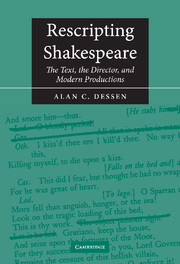Book contents
- Frontmatter
- Contents
- Acknowledgments
- Note on documentation
- List of abbreviations
- 1 “Let it be hid”: price tags, trade-offs, and economies
- 2 Rescripting Shakespeare's contemporaries
- 3 Adjustments and improvements
- 4 Inserting an intermission/interval
- 5 What's in an ending? Rescripting final scenes
- 6 Rescripting stage directions and actions
- 7 Compressing Henry VI
- 8 The tamings of the shrews: rescripting the First Folio
- 9 The editor as rescripter
- Conclusion: what's not here
- Appendix: productions cited
- Notes
- Index
5 - What's in an ending? Rescripting final scenes
Published online by Cambridge University Press: 22 September 2009
- Frontmatter
- Contents
- Acknowledgments
- Note on documentation
- List of abbreviations
- 1 “Let it be hid”: price tags, trade-offs, and economies
- 2 Rescripting Shakespeare's contemporaries
- 3 Adjustments and improvements
- 4 Inserting an intermission/interval
- 5 What's in an ending? Rescripting final scenes
- 6 Rescripting stage directions and actions
- 7 Compressing Henry VI
- 8 The tamings of the shrews: rescripting the First Folio
- 9 The editor as rescripter
- Conclusion: what's not here
- Appendix: productions cited
- Notes
- Index
Summary
“The end crowns all”
Troilus and Cressida, 4.5.224For a variety of reasons theatrical professionals continue to be unsatisfied with the closing moments of Shakespeare's plays as scripted in the Folio and the Quartos, so that a playgoer is especially likely to encounter some form of rescripting in Act 5. Many of these cuts and changes go unremarked by reviewers and playgoers; some adjustments have been readily accepted, even welcomed (for example, omitting Fortinbras so as to end Hamlet with the death of the protagonist – as in the Olivier movie and RSC 1997); a few, such as Nahum Tate's happy ending to King Lear, call attention to themselves like a blinking neon sign.
Often these rescriptings result from the same pressures or rationales described elsewhere in this book. For example, some changes are mandated by the exigencies of a given production. In his tour de force The Comedy of Errors (SSC 1988) Danny Scheie used doors, windows, and other tricks of the trade to enable one actor to play both Antipholus twins, a second to play both Dromios, and a third (at 6′4″ and 240 pounds) to play Solinus and a very hefty courtesan. One casualty of this approach, however, was the final ten lines, for, after leaping over a series of seemingly impossible hurdles in high comic fashion, Scheie opted not to attempt the final Dromio–Dromio beat (5.1.415–26) where the two figures elect to depart “hand in hand, not one before another.”
- Type
- Chapter
- Information
- Rescripting ShakespeareThe Text, the Director, and Modern Productions, pp. 109 - 135Publisher: Cambridge University PressPrint publication year: 2002



